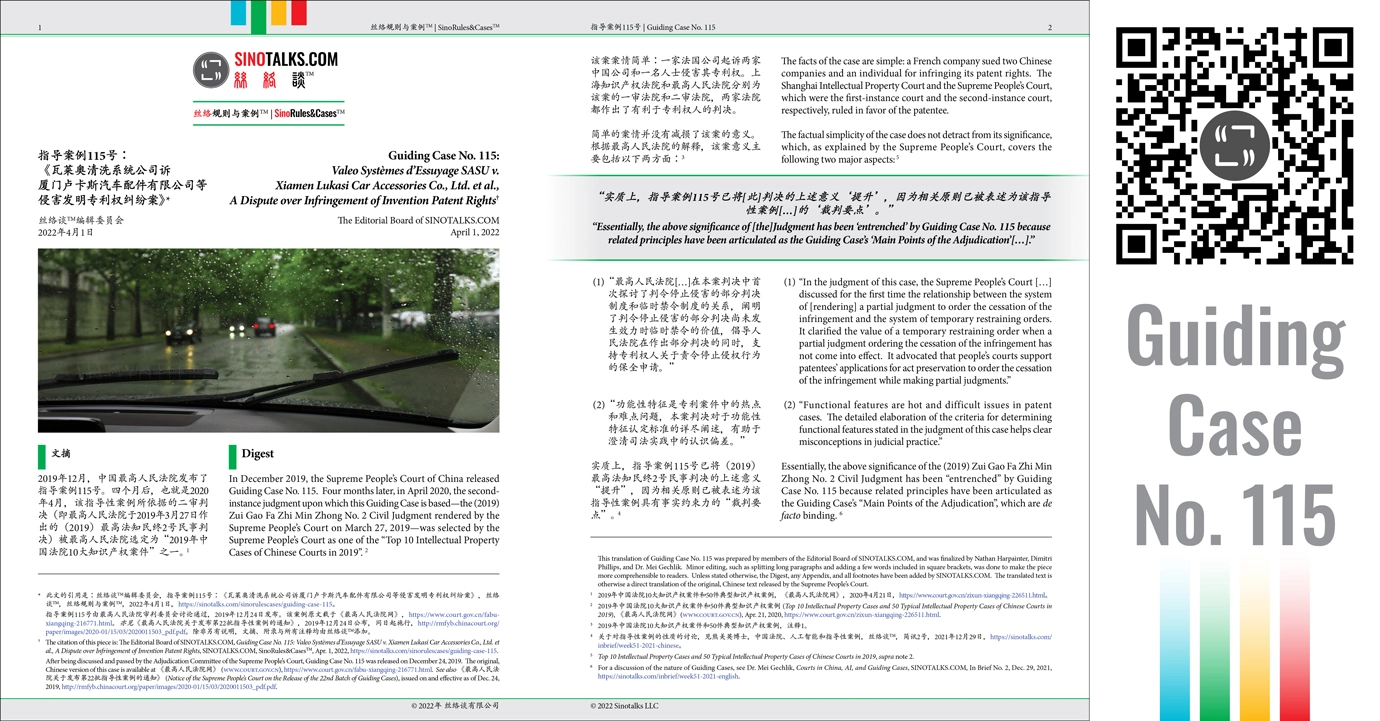Delayed Justice:
China’s Solution for Intellectual Property Cases†
Table of Contents
Estimated Reading Time
- 5.2 min

Justice delayed is justice denied. The prompt delivery of judgments is particularly important in cases involving infringement of intellectual property rights, where holders of these rights need to minimize their losses by stopping the infringement swiftly. China does offer a solution, which President of the Supreme People’s Court ZHOU Qiang described in his annual work report presented in March as “a means to prevent the proliferation of harm, not letting holders of [intellectual property] rights win their lawsuits but lose their markets”. How does this Chinese solution work?
China’s Solution
To avoid delayed justice in intellectual property cases, China has presented a solution that covers two aspects:
- a partial judgment ordering the cessation of the infringement, leaving time-consuming issues, such as the assessment of harm caused and the calculation of compensation, to be dealt with in another judgment; and
- a temporary restraining order, which is formally named “行为保全” (“act preservation”), to order the cessation of the infringement before the partial judgment comes into effect (e.g., a partial judgment that is subject to appeal cannot take effect unless it is upheld by the appellate court).
Guiding Case No. 115

Guiding Case No. 115 (Valeo Systèmes d’Essuyage SASU v. Xiamen Lukasi Car Accessories Co., Ltd. et al., A Dispute over Infringement of Invention Patent Rights) illustrates the significance of combining a partial judgment with a temporary restraining order to produce the desired results.
- Shanghai Intellectual Property Court’s Partial Judgment
Guiding Case No. 115 concerns a lawsuit brought by a French company, which alleged, inter alia, that two Chinese companies had infringed on its invention patent rights. On January 22, 2019, the Shanghai Intellectual Property Court rendered, in accordance with law, a partial judgment, ordering the Chinese companies to immediately cease the infringement of the French company’s rights on the day when the judgment came into effect. Other issues such as the amount of compensation were to be determined later.
- Supreme People’s Court’s Emphasis on Temporary Restraining Orders
The Shanghai Intellectual Property Court’s partial judgment, however, could not stop the infringement immediately because it was subject to appeal. On March 27, 2019, slightly more than two months after the pronouncement of the partial judgment, the Supreme People’s Court rendered the appellate judgment to uphold the partial judgment.
The Supreme People’s Court’s judgment is remarkable because this was the first time that the highest court of China discussed the relationship between partial judgments and temporary restraining orders. The Supreme People’s Court emphasized that courts in China should support patentees’ applications for temporary restraining orders to order the cessation of the infringement while making partial judgments. This, together with the Supreme People’s Court’s clarification of the criteria for determining functional features in an invention, led to the selection of this judgment as one of the “Top 10 Intellectual Property Cases of Chinese Courts in 2019”.
What is even more remarkable is that Guiding Case No. 115 was released in December 2019 to feature this appellate judgment of the Supreme People’s Court. Key principles stated in the appellate judgment are articulated as the Guiding Case’s guiding principles, which are de facto binding (for detailed discussions of the de facto binding nature of Guiding Cases, see SINOTALKS.COM In Brief No. 2 and SINOTALKS.COM In Brief No. 10). A key guiding principle of Guiding Case No. 115 is as follows:
Where a party [to a patent infringement case] applies for both [an act preservation measure] ordering the cessation of an allegedly infringing act and a [partial] judgment to be rendered first to stop the infringement, and a people’s court deems it necessary to first render a [partial] judgment to stop the infringement, [the court] should review the application for act preservation at the same time. If the conditions for act preservation are met, [the court] should make a ruling in a timely manner. (emphasis added)
Guiding Case No. 115 does not provide details about the conditions that need to be met before a Chinese court issues an act preservation order. The SINOTALKS.COM team filled the gap by providing explanatory notes in its high-quality Chinese-English version of Guiding Case No. 115.
Impact in Practice
Apparently inspired by Guiding Case No. 115, the Intermediate People’s Court of Shenzhen Municipality concurrently rendered a partial judgment and a temporary restraining order in November 2020, when it handled a lawsuit brought by SZ DJI Technology Co., Ltd. against two other companies for infringing its appearance design patent rights. This was the first patent infringement case in China where a court rendered both a partial judgment and a temporary restraining order at the same time.
As the combined use of a partial judgment and a temporary restraining order is, as stated by President ZHOU Qiang, “a means to prevent the proliferation of harm”, more holders of intellectual property rights are likely to resort to this means to minimize their losses. How will Chinese courts develop their jurisprudence in this area through cases (e.g., what specific conditions need to be met in different factual situations)? The SINOTALKS.COM team will continue paying close attention to this development and providing updates. If interested, do sign up here to receive our updates.
If you have information about any case involving a partial judgment and a temporary restraining order in China and would like to contribute to our efforts in deepening understanding of this significant area, please contact me (mgechlik@sinotalks.com). Thank you!
P.S. I want to thank David Wei Zhao, Co-Managing Editor of SINOTALKS.COM, for providing research support during the preparation of this article.
† The citation of this article is: Dr. Mei Gechlik, Delayed Justice: China’s Solution for Intellectual Property Cases, SINOTALKS.COM, In Brief No. 11, May 4, 2022, https://sinotalks.com/inbrief/2022w17-english. This article was first published on LinkedIn on April 27, 2022, https://www.linkedin.com/pulse/delayed-justice-chinas-solution-intellectual-property-dr-mei-gechlik.
The original, English version of this article was edited by Nathan Harpainter. The information and views set out in this article are the responsibility of the author and do not necessarily reflect the work or views of SINOTALKS.COM.




